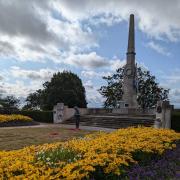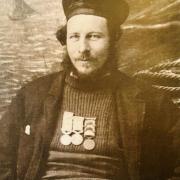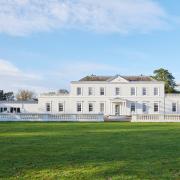It’s the most famous year in British history, 1066, the year of three kings and three battles. The second of them, who died in that final battle, was King Harold II who reigned for just nine months.
Harold Godwinson (son of Godwin), or Harold II, was born around 1022, one of eleven children born to the Earl. He’s Harold II because there’d been an earlier king of England, Harold I, who’d died in 1040. That the first Harold had been a son of Cnut, and therefore a Dane, tells us much about the fractious nature of this period of English history. Harold II was also half-Danish as his mother was a Dane.
Harold II was nominally Anglo-Saxon, or ‘English’, whatever being English meant back then. He was the second son of Earl Godwin (died 1053) who was an early example of the all-powerful magnate; maybe too powerful. As Earl of Wessex he helped plonk Edward the Confessor on the throne in 1042 and around 1044 Godwin used his influence to gain various earldoms for Harold including making him Earl of Essex. He married off his daughter Edith to the king in 1045 which made Harold the king’s brother-in-law. Godwin was the power behind the throne although he had to make a comeback in 1052 after being banished. Edward was perhaps tiring of Godwin’s stranglehold and was leaning towards his cousin, Duke William of Normandy, as an heir, even going as far as nominating him as his successor, whereas the over-mighty Godwin was maybe weighing up his own claim or more likely one of his sons. He snuffed it the following year.

Harold, who’d also suffered banishment, succeeded to the Earldom of Wessex on Godwin’s demise and became Edward’s new right hand man, his ‘under-king’ according to one writer. Three of Harold’s brothers became earls as he tightened his grip. He had his sights on the throne especially after the Saxon heir, Edward the Aetheling, died in 1057. A pilgrimage to Rome in 1058 was followed by more prostration as Harold ‘completed his church at Waltham’, the second reference in his story to Essex. Considering what was coming for Harold, it’s ironic Waltham is considered one of the country’s finest surviving examples of Norman architecture. It had been started in pre-Conquest days by Harold, an admirer of the ‘Norman manner’. Harold was an active patron of various religious houses including the college of canons at Waltham.
There’s a legend associated with the abbey that Cnut’s standard bearer, Tovi the Proud, accompanied a cross from Somerset to Waltham that managed the journey under its own steam. Unsurprisingly the abbey became a magnet for pilgrims and those requiring healing. Harold duly visited this remarkable icon, praying in front of the cross and reputedly being cured of paralysis. Gratitude saw him pay for the church’s rebuilding and he consecrated the church on 3rd May 1060. What remains today is the nave as parish church, with much of the rest lost in the Dissolution of the Monasteries.

As well as duffing up the Welsh, Harold visited Duke William, possibly in 1064. As well as fighting for William it’s possible Harold may have taken some form of oath although whether he would have promised to support William’s designs on the English throne unless compelled to do so is another matter. On returning to England Harold married the widowed Ealdgyth although the delightfully named Edith Swan-neck, who’d borne him five nippers, was still going strong.
In 1065 there was trouble up north with Harold’s brother Tostig ousted. Harold demurred as the Northumbrians chose Morcar as his replacement whilst Tostig licked his wounds and plotted vengeance. When Edward the Confessor died on 5th January 1066, Harold, his final nominee, was chosen as the next posterior on the throne and was crowned the following day. He was a non-royal king but was an anointed one and able warrior. Wrenching the throne from him wouldn’t be easy. The coronation proceeded in Westminster Abbey whilst Duke William hatched invasion plans. There was a third candidate lobbing his titfer in the ring, the Norwegian king, Harald Hardrada, whose principal claim appeared to be his size. Tostig joined him.
Come September Harold had to disband his southern army, which was guarding the coast, as the men needed to get in the harvest, but he must have still feared a strike somewhere. Hardrada and his lackey, Tostig, duly invaded the north and attained the Humber. Having won an eliminator against the northern earls at Gate Fulford they were then soundly undone at the semi-final, the Battle of Stamford Bridge, which has nought to do with Chelsea FC (it’s near York). This bloodbath on 25th September 1066 saw Hardrada and Tostig slain and Harold secure … briefly.
The respite was short lived. Two days later William landed at Pevensey in Sussex. Harold headed 200 miles south, the two armies destined to meet around nine miles from Hastings on 14th October 1066. Harold stopped off at Waltham first though, praying at the church again before continuing his journey towards the south coast, reaching London on the 6th. There are still mysteries surrounding this battle, why Harold elected to fight immediately rather than waiting for reinforcements and why he put himself at such risk that he was killed in the fighting, a rarity for an 11th or 12th century king, yet our Harold was the second royal battlefield goner of 1066. Whether Harold died with an arrow in the eye is a moot point but die he surely did. His body was identified by the loyal Edith Swan-neck and taken ultimately, so we’re told, to Waltham for honourable burial. Some say he was buried in the chancel, the spot marked today on the grass. William was crowned the first Norman king of England on Christmas Day 1066, the third monarch of that tumultuous year, following decisive victory in the third of three battles, the cup final if you will.


NOTE
There is a conspiracy theory too that Harold wasn’t slain at all but survived Hastings, becoming firstly a pilgrim and then a hermit.
CHRONOLOGY
c.1022 – Approximate date of the birth of Harold, son of Earl Godwin.
c.1044 – Earl Godwin uses his clout to gain earldoms for Harold, including Earl of Essex.
1045 – Harold becomes brother-in-law to Edward the Confessor who marries his sister.
1052 – Earl Godwin and Harold make their joint comeback having been banished.
1058 – Harold goes on pilgrimage to Rome, completing his church at Waltham.
1060 – The church at Waltham is consecrated by Harold (3rd May).
1064 – The ill-fated trip to Normandy when Harold is alleged to have sworn an oath.
1065 – Ousting of Tostig in the north which sees him ally himself with Harold Hardrada.
1066 – Death of King Harold at the Battle of Hastings (14th October) aged c.44.



























